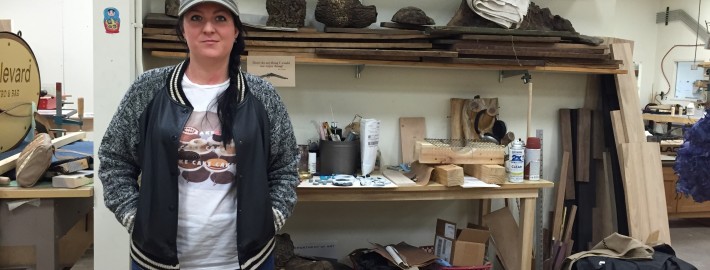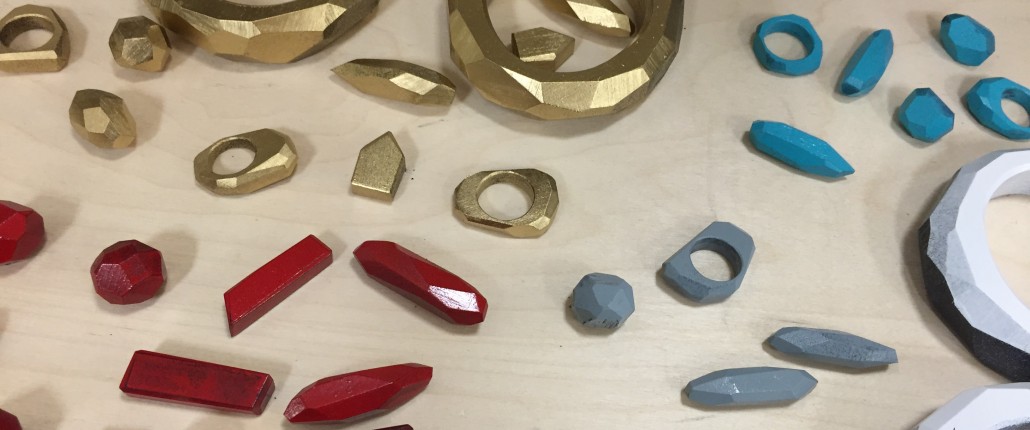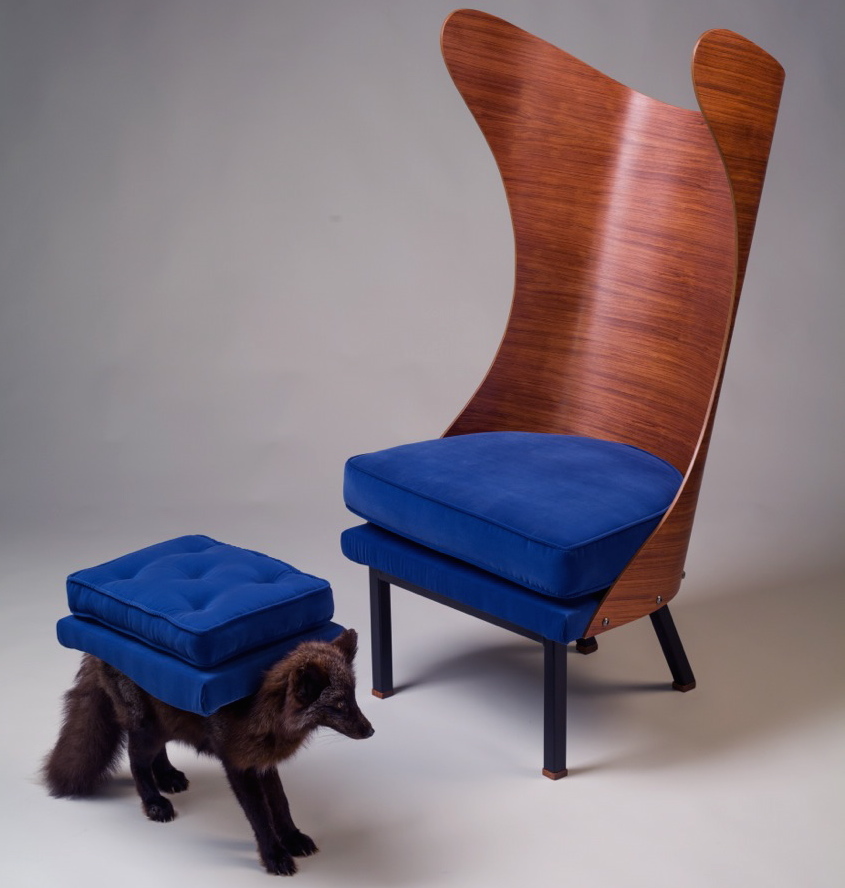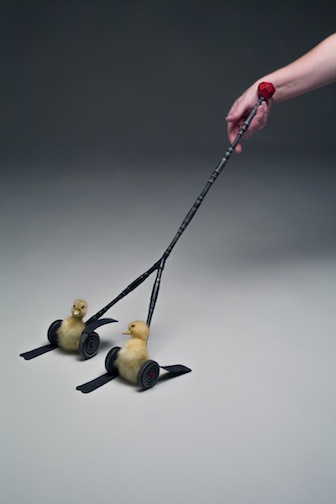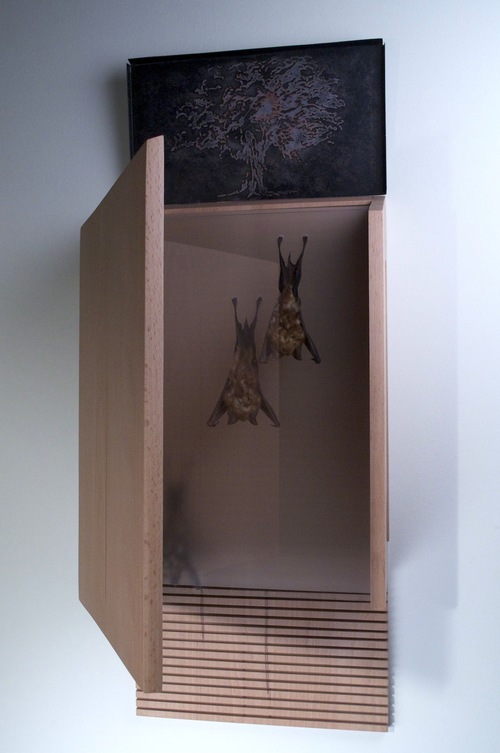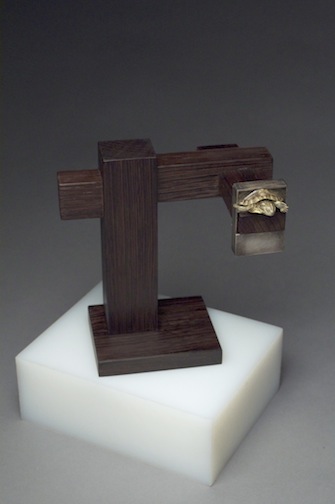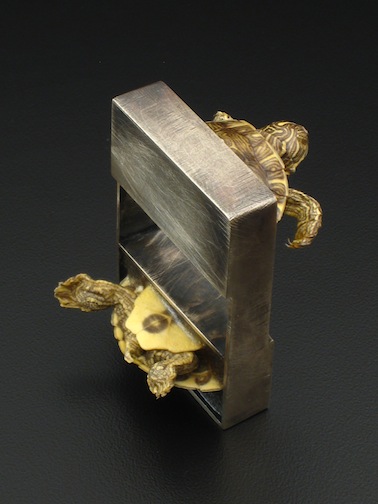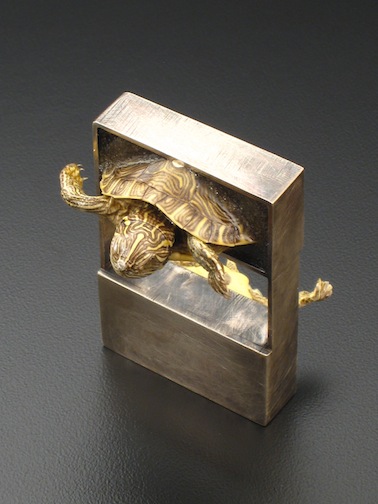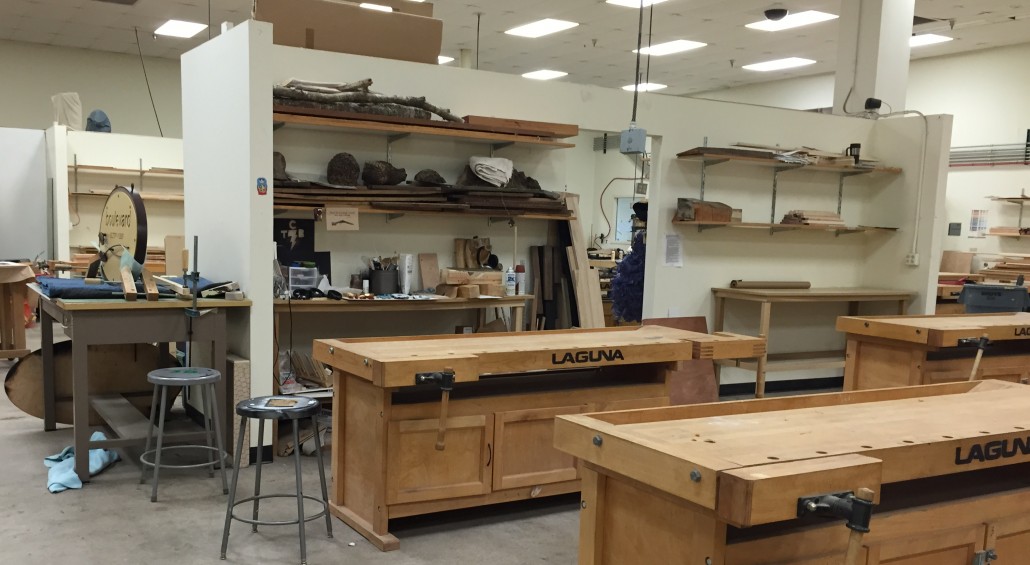Art in the Park: An Interview with Artist Morgan Hill
“I always cared a huge deal about space, the space around me, what makes me feel good in that space” – Morgan Hill
“It’s next to Big Lots,” was all she had told me. When I had agreed to meet artist Morgan Hill at her studio on the University of Arkansas at Little Rock’s campus, I wasn’t expecting the small, shackled building that had been tacked on to an aging strip mall. As is typical for artists and their workspaces, the outside is rarely indicative of the art, artist or process that resides within. Inside, the workshop was cavernous, an endless stock of materials and tools, all permeated with the restless energy of creation. The building holds a woodshop, facilities for metal-smiting, and a textiles room, each one ready for the next class to revive it. As I sat down with Morgan, it became clear that the space was more than just a facility of convenience, but had become an integral part of her growth as an artist.
A native of the small, delta swept town of Wynne, AR, Hill made the move to nearby Memphis to study at the Memphis College of Art and later transferred to the University of Central Arkansas in Conway before finally finding herself and her art in Little Rock. “I knew I wanted to do art, but I didn’t know what I do with it,” she says.
“When I started, drawing was the thing that excited me the most . . . the thing I was using my hands with the most.” She realized early on that she wanted to focus on design. After an attempt at interior design, she found the Applied Design program that allowed her to mix her interest for design with her passion of hands-on processes. “I always cared a huge deal about space, the space around me, what makes me feel good in that space, so furniture made a lot of sense.” She was immediately hooked. “It was exactly what I wanted to do. Finally, after eight years.”
How would you describe the art scene in Arkansas? In Little Rock?
New, upcoming. I’ve gone to Austin for the East Austin Studio Tours the past three years – I have seen how much development there’s been there, and I see that happening here now. Exciting things are going on in SOMA and Argenta: co-ops starting to form, people are starting to get spaces together and have group shows. I hate to leave right now – but I want it to happen and then come back to it. (She is moving to North Carolina to become a fellow at the Penland School of Crafts) I would have loved to be really involved in the first co-op shop for metal/wood work. I was trying to get that going, but at this stage in life people have things they have to do. I realized this was the time that I should go do a residency. I don’t have a child or job that is holding me back.
The time is coming for this city. Little Rock hit the moment where there was enough people coming to the city that there had to be someone looking for a shop or art scene. Most likely these people couldn’t find what they were looking for here and just decided to make it for themselves. Our location in the country has a lot to do with being a tad behind.
Have you experienced that the Little Rock arts community has grown since you’ve been here?
Oh, yeah. I’ve been fortunate enough to be really involved in it. Once I moved here, I immediately became really close to Mia Hall, my Furniture Design professor, and she tried to tell me about everything I needed to be a part of and everyone I needed to meet. So I was quickly friends with a lot of people who were very involved in the art community. That grew, and as I was about to graduate, I became friends with people who could help me post graduation. I met Anita Davis who owns the Esse Purse Museum and has done a lot for the SOMA area to bring up the arts there and develop it. She hired me to be a sales person, and then I became involved in whatever creative project was going on at the museum at the time, and I am now the Creative Director there. I have been with the museum since it opened in 2013.
It’s so much more than people think it is. Everyone just thinks it’s a purse, but it’s not, it’s women’s history. The gift shop is its own exhibit in itself with all handmade things. It’s really awesome.
I don’t know how things just happen, but the last year has been amazing for my career. I have met the right people and been in the right place. You hate to say it, but that’s how it happens and it really, really did.
Tell me more about your business Morgan Hill Creative
About 6 months before I graduated, I realized I needed to get professional with my work. I learned about websites, how to photograph my work, and everything in between. I started business cards, website, all that stuff.
I started making jewelry because I knew I needed something small that I could make fast and sell because takes a while and is expensive. The furniture is very much for a certain type of person. This last year has been focused on developing my jewelry more than anything.
Is the jewelry wood too?
Yes, wood and metal. I carve shapes from a piece of wood. Each piece will speak to me in a different way. I layer with colors and then rub them back to reveal some of the wood.
I have a shop on my website and sell jewelry at the Esse Purse Museum and various shops around the country. That’s been growing. It’s been awesome to see that I can sell jewelry and live off of it; I can actually have a career in this. I wanted to get the jewelry moving in a new direction, but it’s gained such attention that people are interested in the current aesthetic. People are seeing it for the first time in different places so I have had to keep the same aesthetic but also tweak it so that I can stay interested in it.
The furniture is where my heart is. It’s what I want to do whether I make money in it or not.
I saw recently you have done some commissioned work, like at Moxy Mercantile. How do you think about the commissioned work and how does it function differently than your jewelry or furniture? Do you create proposals or have businesses come to you?
So far people have come to me. The first piece I did an installation with yarn. There was an alternative space in Argenta where a women’s group got together and put on a show. I had wanted to draw with string; it’s in the craft field, still, so I thought if it was successful that I would stay interested in it. I began with a portrait of myself with string. From that point, it turned into a thing where people wanted their signs made out of the same technique or random objects. Those commissions are something that I would probably be the least interested in doing now. The first piece I did was the most meaningful – I still have the desire to draw and do line work, but I would rather that have stayed with me. But because it became such a thing and people were interested, I realized it would be a good advertisement and money. I thought I’d rather do it then not. I would like to move from that and somehow incorporate it into the furniture and the three-dimensional stuff that I am doing. I still like it, it isn’t something I want to let go of, but it definitely turned into something that was a little too commercial.
What are you currently working on?
The larger work that I’ve done has been more from workshops that I have taken. Because having a job everyday, I get here (her studio) after work and it doesn’t allow me a lot of time. I have to keep my space clean, so it limits me on the bigger things that I get to work on because I don’t have long periods of time. So the jewelry has been my focus, to get that going and make it something that can sustain me. I have had in the back of my mind that I can’t let go of the furniture part even though I can’t focus on it right now. I have done everything I can to get into a program that allows me to do that. After two years of trying, I got into Penland School of Crafts. In February I will move and be there for two years.
Have you been thinking about the furniture in terms of research, materials or plans since you haven’t been able to work on it?
Yes – I have a stack of ideas and materials that are ready to go.
The taxidermy work that I did for my BFA show is definitely something that is the most important right now. I still want to work with taxidermy. I have been learning the past two years how to taxidermy on my own. The taxidermy work is where I feel most like who I really am, my heart and sole. It’s where my concept comes through and is my more meaningful work. I’ll try once, I am at Penland, to do as much furniture and involve the animal aspect of it.
How did the taxidermy come about?
I grew up on a farm. My dad was a hunter; I was the only child and a girl at that. I was going to go hunting with him, whether I liked it or not. I was immediately disgusted by hunting. I would fall in love with the dead thing that we brought home, and it would become this thing that I thought was precious and I wanted to memorialize it in some way in my mind. My dad wouldn’t let me keep the animals, but I lived with these things on the wall as a child. As I got older I realized that my parents and I had more differences that similarities. Taxidermy became the thing that represented all those differences as I grew – how things changed from what I was taught as a girl to how I think now. It’s been the thing that has stuck with me. I am very attracted to the animals, and I have always been obsessed with death – the lighter aspect of it, at least. Not the heavy, ‘where do we go’ part of the death, but the lighter, humorous, macabre side of death. It just fit with me – it was the thing that had all of those aspects that I was drawn to. All these things are the total opposite of my parents, it’s not something that was ever instilled in me.
Taxidermy is everywhere now, as far as art. I am glad because I get to move anywhere and find a place for myself; it’s not just in the South.
A lot of the taxidermy I have to buy online or on EBay. I just bought a piece of taxidermy that’s a toy that a kid would play with. I really hate seeing older pieces of taxidermy that someone throws away; that’s really sad to me. It’s like throwing away a human being once they are so old that there’s no use for them. The animal has still had a life and is beautiful. I want to find a way to honor these animals. They’re trophies for somebody; let me give them a time to be looked at like they deserve to be. I feel like one day there will be a big movement against the discrimination of animals, like civil rights or women’s rights. I would love for people to consider these animals more than just something to run over. I realized just having a piece of taxidermy in my work said all of these things and I didn’t have to try to verbally explain it.
How do you choose your materials, in terms of wood, etc?
I am attracted to high contrast things. It definitely depends on the animal I’m using. I start with the animal as the source and respond to its color. I’m attracted to light wood usually, the whiter the better. I like more mid-century lines, clean, simple lines, so whatever piece of taxidermy I use stands out. The animal becomes be the most detailed, involved thing for the eye to look at.
Do you see your furniture as functional?
It’s hard for me because I do want it to be gallery work, but I also want it to function now that I am far enough in this field and I know I’ll have to support myself. If I’m going to say I’m a furniture maker, I want it to have function. I want it to have the sculptural, organic gallery presence but also for it to function and work in someone’s home. I’ve encountered those problems already. I made a cabinet that was for bats to live in; it was strictly something for you to look at as art. I need to figure out how to let the audience interact with the work a little more. For the chair and ottoman I made, the ottoman stood on the piece of taxidermy so no one can rest on it.
I want to make sure those things can work together.
I think it’s the right time to be a craftsperson – it’s the beginning of this huge boom. Not that there hasn’t been craft around, but it feels like craft is now something I see everywhere all of a sudden.
What is the best way for you to connect with your audience?
I forced myself. I am not a computer person; I knew Facebook and basic social media, but I had to make a decision to be on top of that. I don’t read books either. I am so visual that it is really hard for me to read. I forced myself to read things that were going to teach me how to do the social media part of business and to talk to people outside of the Little Rock community. That part was easier. I knew how to talk to people and go to things. I could handle Little Rock. But as far as Instagram and Facebook and reaching out to other website that could sell my work, I needed help. I read a whole book about Instagram and how to do it, and it totally worked. I worked really hard on it for a while and now it’s an easy thing. I’ve gotten jobs from Instagram. It really is a thing to know – there is a lot of power in it. It’s just how the world is now.
I keep applying to shows in different places. I have gotten in little shows and some bigger ones that I never thought I would get into because of social media. On Instagram, you tag the right person and that’s it, that’s all that has to happen. There’s a store in Michigan that has my stuff, a really cool boutique, just because I tagged a picture.
Do you look to any artists for inspiration? What type of conversation would you hope your work to be a part of?
I hope to be involved with different groups, but I don’t think I’m there yet. There are a lot of artists working in taxidermy and I would love to jump into that and somehow be a part of that conversation. When someone wants to write about work with taxidermy in it, I would love for my work to come up. There aren’t a lot of furniture makers who use taxidermy in their work, so that’s a good thing. I would really feel successful if those people that I’ve looked at the most through out this taxidermy work recognized me.
Other than that, it’s really local. I definitely feel a part of the group that I graduated with; we are still very close and are really trying to make it. We’re really worried about each other and about helping each other. The group is about to spread out a little bit from Little Rock. It’s been different from what I’ve seen in other schools or other relationships that I have. We all want to find success in our degree and are sticking with it. Right now my classmates are trying really hard to be the people who change things here in Little Rock. I haven’t felt that way any other place I’ve lived.
I tried several different things and realized this [art] is the only thing I know and the only thing that is going to make me happy. It’s the only thing I am going to allow myself to do, if that’s the case. Money doesn’t mean a lot to me; as long as I can take care of myself that’s all I really need. My parents absolutely hate hearing that, but they’re coming around to the idea of me being an artist for the rest of my life. I’m very lucky to have parents who are still growing.
Any parting words?
Recently I’ve been really thinking about where I want my work to go. Talking about my work used to be really complicated. I would really like to simplify what my work is, not just visually, but to make it a more universal thing that people can really walk up to and understand. A simple understanding, not something that makes them feel all of the emotions. Something peaceful and funny. I would really like my work to be easy and express what I feel about it. It’s very simple. It’s this silly idea of the death part of life.
You Can Find More of Morgan Hill’s work at:
Wildwood Park for the Art’s Art in the Park exhibit until February 15 and at UALR’s The Penland Experience
You can follow her on Instagram here and on Facebook here.

